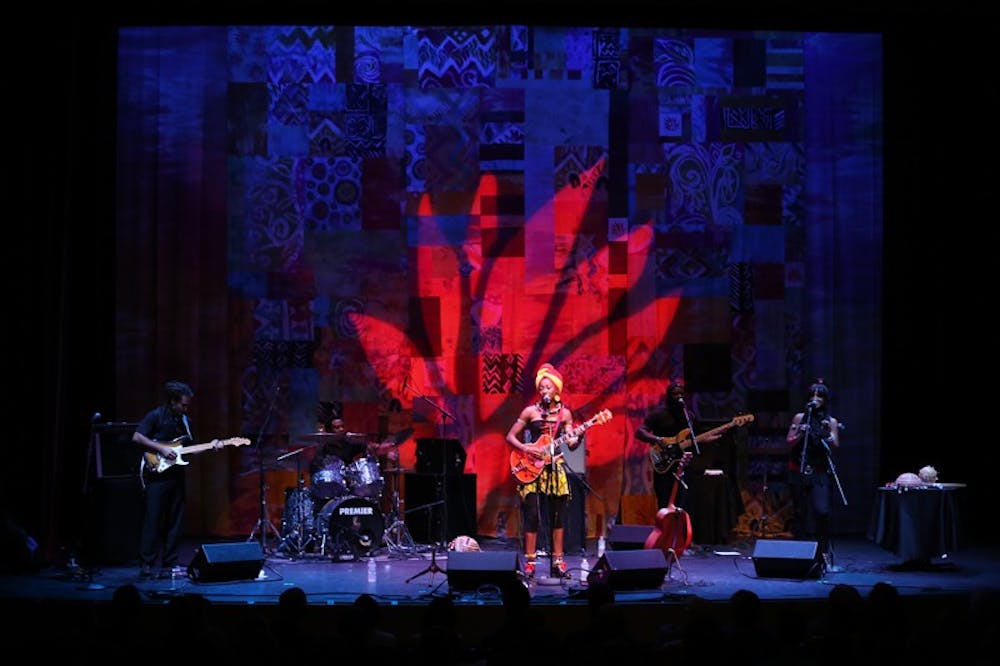Shortly after Dickey died of leukemia in 1989 in Paoli, Indiana, a local grocery store owner approached his son, Stephen, about paying Lotus’ tab. Larsen said Stephen was confused – a tab for a grocery store?
The owner explained Lotus had been paying the price of food for an impoverished family in the community for years. It was an astounding revelation, as Lotus himself was considered a poor man.
“He was the most enlightened being I’ve ever known,” Larsen said.
Lotus, a fiddler, singer, guitarist and songwriter, is remembered by the Bloomington community for four days each year with the Lotus World Music and Arts Festival. Since its first occurrence in 1994, the festival has included a tribute to the Orange County musician.
It was in that first year that Larsen, who was mentored by Lotus, was approached about forming the tribute. He gathered a group, six to eight people who had been friends with Lotus, and put together a free concert named the “Lotus Dickey Tribute.”
In the past few years, the tribute has taken the form of a workshop, Larsen said, and the event was renamed the “Lotus Dickey Song Workshop.”
Audience members receive handouts with the lyrics of Lotus’ songs and are invited to sing along.
Sunni Fass, executive director of the Lotus Education and Arts Foundation, said the name of the festival was chosen by its three founders — Lee Williams, James Combs and Shahyar Daneshgar — for two reasons, and honoring Lotus Dickey was half of that equation.
“The group chose the lotus flower to represent the other half: a bloom which grows all over the world, including here in Indiana, and also has deep connections to many other world cultures and religions,” Fass said. “Many people think it was all about the man, but the name of the Lotus World Music and Arts Festival has very intentionally represented a man and a flower from the very beginning.”
The evolution of the festival includes a change in venues along with a swell in attendance, Fass said.
The first year, which sold out, used only three venues: the porch of the Mathers Museum, the Waldron Arts Center and Second Story Club, which has since closed.
There was a small parade that year from the concert at Mathers to the Waldron, “specifically to symbolize connecting the community and IU,” Fass said.
By the second year, the Wild Beet, now the Bishop, was added to the list of venues. Visual art was also introduced in the second year and remains a key aspect of the festival.
“For over a decade now, the large backdrops in the Buskirk-Chumley Theater have been a visual arts highlight for Lotus audiences, over the years representing the work of a variety of Bloomington artists and community participants,” Fass said.
The third year, 1996, brought five total venues and a necessary closing of the streets for pedestrian safety.
It was also in 1996 that Larsen, Nancy McEntire and Janne Henshaw finished “The Lotus Dickey Song Book,” a project Larsen promised to Lotus just before his death, he said.
Larsen wrote a letter to Noah Adams, an anchor for national radio show “All Things Considered,” to inform him about the book. The resulting story — about the book, Lotus Dickey and the festival — premiered just before the tribute show that year.
Larsen remembers listening to it backstage at the Waldron Arts Center just before performing.
In 2005, a partnership between the Lotus Festival, Mark Kruzan and the City of Bloomington resulted in Lotus in the Park, a free concert amid the rest that charge admission.
Larsen said if Lotus were alive today, he would have loved to attend the festival and would urge people to approach the festival with a spirit of openness and curiosity.
“He just had kind of a voracious appetite for music and creativity, new sights and sounds,” Larsen said.
“It would be a fine tribute to him for people to open their ears, open their eyes, open their minds and take in the beauty of the music from all over the world.”




